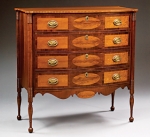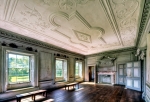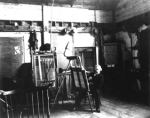|
Thursday, 14 February 2013 05:05
For over one hundred and fifty years the V & A has been collecting furniture and displaying it alongside the other decorative arts in its major galleries, but until now it has never had a gallery focussed solely on furniture and how it was made.2 Moreover, the Dr. Susan Weber Gallery (Fig. 1), which opened in December 2012, is the only dedicated gallery in the world to show a comprehensive display of Western furniture from the Middle Ages to the present day. Like the V & A itself, the new gallery is intended to be a resource for designers and makers, conservators and restorers, students and collectors, but is also for anyone with a curiosity about furniture or a desire to understand how things are made.
Thursday, 14 February 2013 04:52
The new installation of the Grainger Gallery of Folk Art at the Art Institute of Chicago opened in August 2009 in a renovated gallery space that wraps around the historic Ryerson and Burnham library in the original 1893 building of the museum. Endowed by David and Juli Grainger, the reinstallation of the collection prompted a re-assessment of the museum’s American folk art collection and provided the opportunity for new research and a publication, also funded by the Grainger Foundation. For Kith and Kin is the first publication to document the growth of folk art collecting in Chicago and at the Art Institute during the late-nineteenth and early-twentieth centuries. Over sixty objects are illustrated with short essays accompanying each entry. An essay on the collecting of folk art in Chicago describes the previously unpublished history of the collection’s origins and growth.
Saturday, 09 February 2013 06:34

Even in a long museum career, it is unusual to have the pleasure of working with the same objects more than once. I first met George M. and Linda H. Kaufman in the National Gallery of Art’s design studio in 1979, when they were lenders to In Praise of America: Masterworks of American Decorative Arts, 1650–1830. Subsequently, in 1986 the Gallery devoted ten rooms to an extensive exhibition based exclusively on the Kaufmans’ collection. A wonderful relationship was forged between the collectors and the Gallery, and the recent opening of Masterpieces of American Furniture from the Kaufman Collection, 1700–1830, celebrates the Kaufmans’ generous promised gift to the National Gallery. This permanent installation consists of more than one hundred objects from one of the most important privately assembled collections of early American furniture and decorative arts. The addition of the Kaufman Collection significantly enhances the National Gallery’s decorative arts holdings, providing open access in our nation’s capital to seminal examples of early American furniture.
Saturday, 09 February 2013 06:24

On the morning of May 11, 1972, fifty people gathered in the double-parlor of the Higginson House, an elegant Federal dwelling on Boston’s Beacon Hill that serves as the home of the Colonial Society of Massachusetts. The moment marked the start of a two-day conference on Boston furniture of the eighteenth century. Organized by Jonathan Fairbanks, then curator of American decorative arts and sculpture at the Museum of Fine Arts, Boston, and Walter Muir Whitehill, president of the Colonial Society, the event brought together such seasoned speakers as Richard Randall and Dean Fales as well as four young graduate students from the Winterthur program in early American culture. During the afternoon the conference moved to the Museum of Fine Arts for more presentations and a tour of a small exhibition of Boston masterpieces entitled A Bit of Vanity, Furniture of Eighteenth-Century Boston. The event concluded the next day back at the Colonial Society’s headquarters. Over the next year, speakers turned their talks into papers, and in 1974 the Colonial Society published Boston Furniture of the Eighteenth Century. The volume quickly became a standard reference for anyone interested in early American furniture.
Thursday, 07 February 2013 04:49
A major exhibition of work by American artist Walter Gay (1856–1937) on display at the Henry Morrison Flagler Museum in Palm Beach, Florida, examines the life and work of an American artist who specialized in painting the sumptuous domestic interiors of wealthy collectors and society figures in late-nineteenth and early-twentieth-century America and Europe. Impressions of Interiors, organized by the Frick Art & Historical Center, features sixty-nine paintings and a selection of historical materials on loan from forty public and private collections including: the Art Institute of Chicago; Museum of Fine Arts, Boston; Metropolitan Museum of Art; Musée d’Orsay; and the Smithsonian American Art Museum. Many of these works have not been publicly exhibited since Gay’s lifetime.
Thursday, 07 February 2013 04:42
Last June, the Menil Collection (Fig. 1) in Houston, Texas, celebrated its twenty-fifth year as a public institution. Situated in Montrose, an inner-city enclave populated by residential blocks, the Menil houses the privately assembled collection of John and Dominique de Menil.
Thursday, 07 February 2013 04:33

At Drayton Hall, a historic site of the National Trust for Historic Preservation in Charleston, South Carolina, a museum interpreter, about sixty-five years old, welcomed a group of elementary school students to the site. She summarized the history of the plantation and explained that construction of its main house had begun in 1738. When she paused for questions, a student politely raised her hand and asked, “Were you living here when the house was built?” Another story comes from the manager of the museum’s shop where Civil War caps from both armies are sold. About twice a month, adults ask the manager, “What’s the difference between the blue cap and the gray?” Such stories are told across the nation, but are not relegated to historic sites. Pulitzer Prize-winning historian David McCullough tells of giving a lecture at a well-respected college in the Midwest. Afterwards, a bright student told him, “Until I heard your talk, I’d never realized the original thirteen colonies were all along the East Coast.”1
Tuesday, 05 February 2013 01:23

Framed by the flickering flames of gaslight sconces, textured cast-glass door panels sparkle in the twilight, their magical glow hinting at the resplendent interior within. Possessing a marvel and passion for a time that New York has long since forgotten, Michael and Margie Loeb have spent the last decade taking their six-and-a-half-story brownstone on Manhattan’s Upper East Side back to its nineteenth-century roots while making it into their own twenty-first-century home.
The Loebs, who share the 1882 Neo-Grec townhouse with their fourteen-year-old triplets, restored the residence and furnished it with nineteenth-century artwork as well as Aesthetic Movement furnishings, fixtures, and decorative accessories.
“The house had an astonishing amount of intact original detailing,” Michael says. “The first time I saw it, it took my breath away. I got as far as the dining room and said, ‘We’ve gotta have it.’”
The couple began collecting nineteenth-century American antiques when they were restoring their previous Manhattan townhouse, and this brownstone, the only private house left on the block, gave them the opportunity to edit and upgrade. “We’re fascinated by nineteenth-century decorative arts,” says Margie, “and we were eager for the interiors to be true to the spirit of that era, but this is also our home and it had to be a comfortable, practical place to live with our children.”
Tuesday, 05 February 2013 01:08
Prominently situated on the shore of Newport Harbor in the historic Easton’s Point neighborhood, Hunter House (circa 1748) (Fig. 1) exhibits the work of craftsmen practicing in eighteenth-century Newport, Rhode Island. The collection demonstrates the quality and breadth of Rhode Island-made furniture, silver, and pewter, among other decorative and fine arts. The northeast parlor of the house and its interior woodwork, rich in classical details, serves as a backdrop for the collection. Here, locally made wares appear in their appropriate domestic context: within an eighteenth-century structure, its original interiors, and in constellation with the objects used alongside them. Newport’s distinct design tradition is evidenced in the decorative arts and architecture of the house, which reveal the variety of artisans working in close proximity to one another and to Hunter House in the second half of the eighteenth century.
Tuesday, 05 February 2013 00:47
Newport, Rhode Island, retains more of the imprint of each successive era of American history, more thoroughly preserved, than anywhere else in the United States. The people who live here, and even those who just come to visit, seem to develop fervor for the place. Can one small town on a small island in the smallest state be that significant?
Tuesday, 05 February 2013 00:32
Winterthur, set on 980-acres in northern Delaware, is charged with the management, preservation, and interpretation of over 850,000 objects in the museum, garden, and library collections combined. But there is only one antique at Winterthur you may see driving around the grounds: an American built 1927 Rolls-Royce Phantom I.
Friday, 01 February 2013 05:07
Despite worries on Wall Street and gridlock in Washington, 2012 was another good year for acquisitions at America’s major art museums. Around the country, many museums have not found donors to be “any less generous,” according to Terry Morello, vice-president for external affairs at the Los Angeles County Museum of Art. “People give out of a commitment to the museum.” Similarly, there “was little or no change from previous years” in the gifts made to the Detroit Institute of Art, according to a museum spokeswoman, and the same was true for both the Walters Art Museum in Baltimore and Boston’s Museum of Fine Arts.
Friday, 01 February 2013 04:57
If there is a downside to my otherwise terrific job as executive producer of PBS’s Antiques Roadshow, it’s that I want things—expensive things—that I never wanted before. My wish list is enormous because I’ve seen and touched the best. I even have my own Roadshow fantasy of finding a superb marine painting by James Edward Buttersworth and buying it for less than $100 because it was hiding under a paint-by-numbers board.
As long as I’m in a Roadshow fantasy bubble, I’m going to imagine what would happen if I could shop from among our guests’ treasures. The aforementioned marine painting would be high on my shopping list—either a Buttersworth or an Antonio Jacobsen would do. I’d be tempted to acquire a nice little folk art painting by Grandma Moses, and I’m salivating for a Rockwell Kent, just like the one we discovered in Pittsburgh in 2011.
Wednesday, 30 January 2013 02:06
When Henry Francis du Pont inherited his family’s country estate, Winterthur, in 1926, his newfound passion for collecting the best in early American architecture, antiques, and fine art found its ultimate expression. His desire to share that passion led to the opening of Winterthur as a museum in 1951 (Fig. 1). In support of that venture, Charles Montgomery, hired to catalogue the collection, encouraged du Pont to endorse the creation of an onsite graduate program dedicated to the study of American antiques. With the support of the University of Delaware, two master’s degree programs were subsequently designed. The first five students began their studies in early American material culture in 1952 (Fig. 2); presently, eight students participate in the Winterthur Program in American Material Culture. The program in art conservation—now the Winterthur/University of Delaware Program in Art Conservation—was added in 1974 (Fig. 3), and currently accepts ten students annually.
Saturday, 26 January 2013 03:35
Among the most entertaining objects associated with alcohol consumption are those showing the humor often associated with drinking. As production costs for ceramics, glass, prints, and other objects gradually lowered during the 1700s, such items made “purely for fun” became more widely available.
William Hogarth’s famous print A Midnight Modern Conversation (London, 1732/33), portrays a raucous group of men sharing wine and punch. The scene is reproduced here in painted form inside a rare English delft punch bowl (Fig. 1). Hogarth’s print, possibly a satire on drinking clubs, was for sale in 1750s Philadelphia and reappeared painted on elegant Meissen (German) porcelain and even as life-sized wax figures that could be viewed for the cost of an entrance ticket.
Friday, 25 January 2013 04:03
Of the many fine artists who were drawn to Rhode Island’s Newport and Narragansett Bay region during the 1800s, perhaps no other has better captured the mercurial sea or “the miracle of color under a curving wave,”2 than William Trost Richards (1833–1905). Richards spent decades painting in and around Newport, and in a scenic area in nearby Middletown known as “Paradise.” His oil and watercolor seascapes created there and along the New Jersey and British coasts are considered among the finest ever produced. Richards embraced first the tenets of the Hudson River School, later developing a Pre-Raphaelite concern for closely observed natural details. As a mature artist, he combined this truth to nature with an interest in light and atmosphere, attributes that permeate the works he created in the Newport area in the 1890s.
Friday, 18 January 2013 04:34
“I don’t paint portraits; I paint people in their homes,” Edouard Vuillard (1868–1940) famously said. Wallpaper, lamps, blankets and shawls, musical instruments, books, and paintings were all clues that revealed the taste and character of his subjects, at home in their habitat. His enthusiastic patrons, many of whom were Jewish, included his dealers, collectors, publishers, and theater impresarios. He, in turn became their chronicler, opening a window into their elegant world as he recorded the rich social and cultural life of fin de siècle France through 1940. Among this group were the three women who served as his muses during the various stages of the career of the bachelor Vuillard. They were, first and foremost, his mother; Misia Natanson, the kittenish concert pianist and wife of publisher Thadée Natanson; and the pugnacious Lucie Hessel, wife of art dealer Jos Hessel.
Thursday, 17 January 2013 02:39

During the post-whaling era of the 1870s–1890s, many prominent American artists were drawn to Nantucket for its antiquated charm and picturesque vistas. George Inness and William Trost Richards were among those who joined the ranks of Nantucket-descended talents such as W. Ferdinand Macy and John Alexander MacDougall Jr. in portraying the island’s lush natural settings, interesting characters, and alluring seascapes and landscapes. Genre painter, portraitist, and chronicler of American life, Eastman Johnson (1824–1906) first visited Nantucket in 1869, and soon took up seasonal residence on the island, purchasing a home and artist studio on North Street (now Cliff Road) in the area known as The Cliff—on the North Shore facing Nantucket Sound. The artist’s island sojourns would inspire some of his most enduring works, including his masterpiece, The Cranberry Harvest—Island of Nantucket (1880). After its completion, Johnson turned his attention to portraiture, taking advantage of the community of grizzled veterans of the sea who haunted Nantucket in the twilight of the nineteenth century, as well as his new neighbors who included retired mariners, civic officials, and practicing artists.
Thursday, 17 January 2013 02:19
“Egypt,” an idyllic hill farm situated in an isolated hollow high on the slopes of Red Mountain in Arlington, Vermont, served as home base for the artist Rockwell Kent (1882–1971) and his growing family from the summer of 1919 to the summer of 1925. Arriving in Vermont on the heels of a sojourn to Alaska and buoyed by the critical and financial success of the work he had commenced there, including his travel memoir, Wilderness: A Journal of Quiet Adventure in Alaska, Kent quickly rose to become one of the most renowned artistic figures in America. Despite the fact that this period proved to be pivotal in the arc of Kent’s career, the artist’s seminal years in Arlington have been largely overlooked.
Thursday, 03 January 2013 04:37
The New-York Historical Society holds one of the finest collections of early American silver in the nation. A trove of nearly three thousand objects, it is remarkable for being composed almost entirely of silver donated by descendants of the original owners, who preserved their inherited tankards and teapots as tangible links to New York’s past. Appreciated today for their workmanship, aesthetic qualities, or rarity, these pieces have additional layers of meaning conferred by the patina of successive generations of use. The richly documented objects open a window onto silver’s symbolic meanings, its role in sustaining kinship ties, and its ability to convey the ambitions and achievements of its owners.
|
|
|
|
|